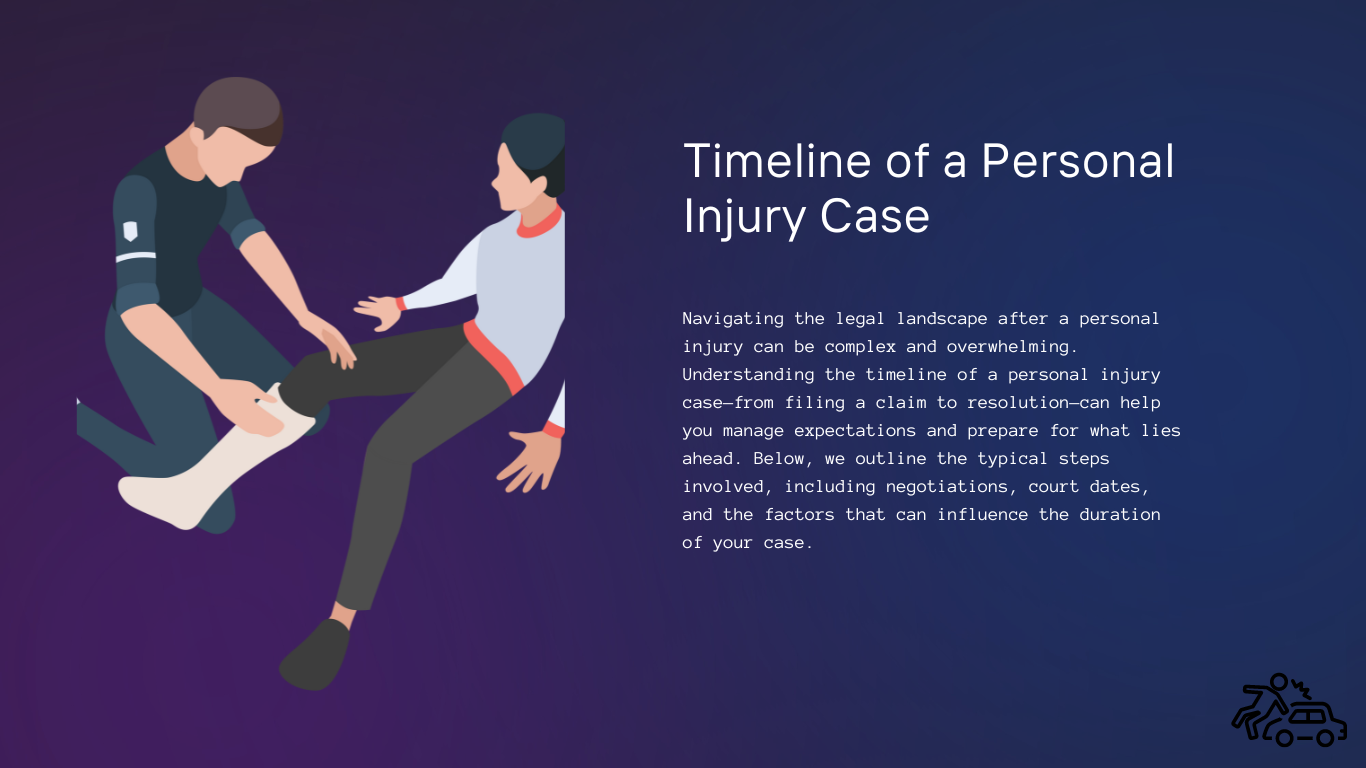The Timeline of a Personal Injury Case
Navigating the legal landscape after a personal injury can be complex and overwhelming. Understanding the timeline of a personal injury case—from filing a claim to resolution—can help you manage expectations and prepare for what lies ahead. Below, we outline the typical steps involved, including negotiations, court dates, and the factors that can influence the duration of your case.
You may more about this: content writing and editing
1. Initial Consultation (1-2 Weeks)
The timeline often begins with an initial consultation with a personal injury lawyer. During this meeting, you’ll discuss the details of your case, including the accident, injuries sustained, and any medical treatment received. The lawyer will evaluate the strength of your claim, discuss potential compensation, and outline the next steps.
Key Considerations:
- Bring all relevant documents, such as medical records and accident reports.
- Ask questions about the lawyer’s experience, fees, and approach.
2. Investigation and Gathering Evidence (2-6 Weeks)
Once you hire a lawyer, they will conduct a thorough investigation. This process includes gathering evidence such as police reports, medical records, photographs of the accident scene, and witness statements. The attorney may also consult with experts (e.g., accident reconstruction specialists) to build a strong case.
Key Considerations:
- The more evidence gathered, the stronger your case will be.
- Be patient; thorough investigations can take time.
3. Demand Letter (2-4 Weeks)
After completing the investigation, your lawyer will draft a demand letter to the insurance company of the party at fault. This letter outlines the details of the accident, your injuries, medical treatment, and the compensation you seek. This formal request kicks off the negotiation process.
Key Considerations:
- The demand letter should be comprehensive and well-supported by evidence.
- It sets the stage for negotiations and can influence the settlement amount.
4. Negotiations (4-8 Weeks)
Following the submission of the demand letter, negotiations with the insurance company begin. This phase can vary in length; it may take a few weeks to several months, depending on the complexity of the case and the willingness of both parties to compromise.
Key Considerations:
- Be prepared for counteroffers and possible back-and-forth discussions.
- Your attorney will advocate for your interests, aiming to secure a fair settlement.
5. Filing a Lawsuit (2-3 Weeks)
If negotiations do not result in a satisfactory settlement, your lawyer may recommend filing a lawsuit. This involves preparing and submitting a complaint to the appropriate court, outlining your claims against the defendant. The filing of the lawsuit typically takes a few weeks.
Key Considerations:
- A lawsuit can prolong the process but may be necessary to achieve fair compensation.
- Understand that litigation can be more public and may require additional time and resources.
6. Discovery Phase (3-6 Months)
Once a lawsuit is filed, the discovery phase begins. During this time, both parties exchange information, evidence, and witness statements. This phase can be lengthy, as it involves depositions, interrogatories, and requests for documents.
Key Considerations:
- Discovery is crucial for both sides to understand the case better.
- Your lawyer will prepare you for depositions and ensure your interests are protected.
7. Pre-Trial Motions (2-4 Weeks)
Following the discovery phase, either party may file pre-trial motions. These motions can address various issues, such as dismissing parts of the case or excluding certain evidence. The court will schedule hearings to address these motions.
Key Considerations:
- This phase can further extend the timeline but is essential for clarifying legal issues.
- Your attorney will inform you of the potential impacts of these motions on your case.
8. Settlement Negotiations (Ongoing)
Even during the litigation process, settlement negotiations can continue. Many personal injury cases settle before reaching trial. Your lawyer may initiate discussions or respond to settlement offers during this time.
Key Considerations:
- Settlement discussions can happen at any point, even right before trial.
- Evaluate the pros and cons of settling versus going to trial, considering time, costs, and potential outcomes.
9. Trial (1-3 Weeks)
If your case does not settle, it will go to trial. Trials can vary in length but typically last from a few days to several weeks. During the trial, both sides present evidence and arguments, and a judge or jury will ultimately render a verdict.
Key Considerations:
- Be prepared for the emotional and time commitment involved in a trial.
- Your attorney will guide you through each step and prepare you for what to expect.
10. Post-Trial Motions and Appeals (Varies)
Following a trial, the losing party may file post-trial motions or appeals, which can further extend the timeline. This phase involves legal arguments regarding the trial’s outcome, which can add several months or even years to the process.
Key Considerations:
- Understand that appeals can complicate and prolong the resolution of your case.
- Discuss with your attorney the likelihood of success on appeal and its potential impact on your case.
Conclusion
The timeline of a personal injury case can vary significantly based on numerous factors, including the complexity of the case, the willingness of both parties to negotiate, and the legal jurisdiction. While some cases may settle quickly, others may take months or even years to resolve.
Understanding each phase of the process can help you feel more prepared and informed as you navigate your personal injury claim. A skilled personal injury lawyer will be your best ally, guiding you through each step, advocating for your rights, and working to secure the compensation you deserve. Remember, patience and persistence are crucial in the pursuit of justice and fair compensation for your injuries.

